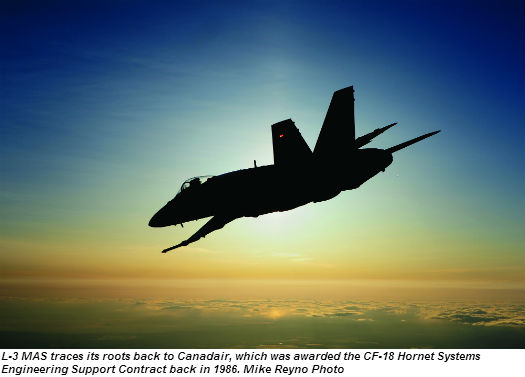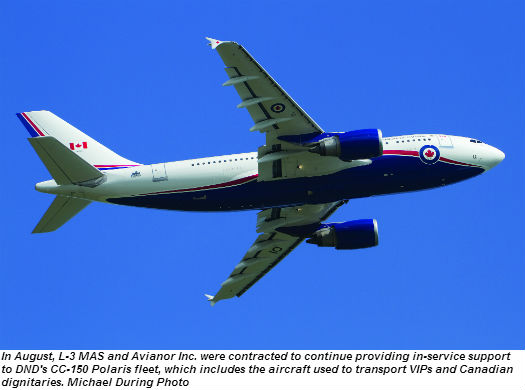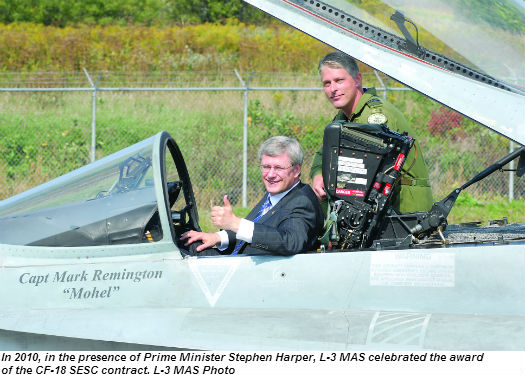It’s Monday morning, and Jacques Comtois is on his way to meet with the newest group of employees at L-3 MAS. As the company’s vice president and general manager, Comtois believes a new employee’s perception of their employer is cemented during the first week on the job – so he’s made it a point to have regular Monday morning meetings with new hires.
“Some of these new employees weren’t even born when Canada acquired the CF-18 Hornet,” Comtois told Canadian Skies during a recent visit to L-3 MAS in Mirabel, Que. “It’s important that they learn our company history. They must also understand our mission and vision, especially the values that form our culture. At their briefing, they are given a values reminder card that attaches to their I.D. badge.”
The history Comtois shares with new employees is closely tied to military aviation; it extends back to the organization’s Canadair roots, when the seeds were sown for developing world-class capabilities in military aircraft fleet management, modification, life cycle monitoring, and maintenance, repair and overhaul (MRO) services.
HORNETS IN CANADA
In April of 1980, the Canadian government announced it had chosen McDonnell Douglas’ F/A-18 Hornet as Canada’s next fighter jet. After a three-year RFP and selection process associated with the so-called New Fighter Program, Ottawa selected the F/A-18 based on its performance as well as an attractive package of associated industrial and regional benefits (IRBs). The latter were aimed at offsetting the final acquisition cost of the jets, which was estimated at US$2.8 billion (in 1989 dollars).
Offsets related to the Canadian jet purchase were to be provided by manufacturer McDonnell Douglas (MD) and its major subcontractors, according to a 1990 report entitled, “F/A-18 Sales to Canada, Australia and Spain: A Case Study of Offsets,” produced by the U.S. Office of Management and Budget. They were designed to achieve a number of Canadian government objectives, among them advancing Canada’s industrial capability (especially for in-country life cycle support of the jets), stimulating technological advancement, improving the country’s competitiveness on a global scale, encouraging exports, and creating high-paying skilled jobs across the country.
The New Fighter Program was a highly competitive procurement, which led to the submission of very attractive industrial offset bid packages. In fact, MD’s winning proposal was valued by the government of the day at about 110 per cent of the value of aircraft production work realized by MD from the Canadian order, and was expected to create 24,000 related jobs.
At the time, no one could possibly have realized the far reaching future effects of Canada’s CF-18 procurement. But
33 years later, it’s clear that those very same industrial offsets have hugely impacted the development of the Canadian aviation and aerospace industry. In fact, they were the foundation of what today is considered a global centre of excellence in F/A-18 maintenance – a home-grown facility that is located right here in Canada.
FROM CANADAIR TO L-3
In 1986, the Department of National Defence (DND) selected the Defense Systems Division of Canadair – a federal crown corporation – as the prime contractor for the CF-18 Systems Engineering Support Contract (SESC). The contract’s scope covered structural modifications, upgrades to the CF-18’s avionics equipment and software, as well as fleet management disciplines such as integrated logistics, data management and technical publications support. A partnership was formed with another Montreal-area company, CAE Inc., with that organization providing systems, software and electronics support, and Canadair contributing structural and platform expertise.
The added SESC work necessitated expansion, so Canadair made plans to move to a larger facility at Montreal’s Mirabel International Airport. In the meantime, however, the company was posting record losses as it struggled to develop its Challenger business jet. In December 1986, just months after its maintenance division had been awarded the CF-18 SESC contract, the federal government sold Canadair to Bombardier, Inc. That sale led to the creation of what is known today as Bombardier Aerospace.
Under that umbrella, Bombardier’s Defence Services unit provided MRO and technical services for military aircraft. The division was involved with not only the CF-18, but also the Canadair CT-114 Tutor, the missionization of the Challenger for various customers, the NATO Flying Training in Canada (NFTC) program, the Civil Aviation Training Centre (CATC) pilot training initiative, the CL-89, CL-289, CL-227 and the CL-327 series of unmanned aerial vehicles (UAVs), and the Australian F/A-18. Bombardier Military Aviation Services (MAS) became known as an expert authority in military aircraft modernization and life cycle management.
In the meantime, the company’s aerospace and rail divisions had been growing rapidly; in 2003, the decision was made to concentrate on development and production, and the MAS unit was sold to New York-based L-3 Communications Inc., which had previously purchased Spar Aerospace in 2001.
“Historically, we’ve been very much aligned with supporting Canadian government fleets,” said L-3 MAS’ Comtois, who enjoyed a 22-year military career followed by employment with Spar Aerospace, Rolls- Royce, and Bombardier, before joining L-3 MAS in 2012. “(We’ve worked on) the CF-18, obviously, but also the Canadair CT-114 Tutor fleet; and along the way, we have picked up the CH-148 Cyclone Maritime Helicopter Program, portions of the Boeing CH-147 Chinook, and most recently the Airbus 310 CC-150 Polaris.”
In August, L-3 MAS and its partner, Avianor Inc., won a follow-on contract to continue providing in-service support to DND’s Polaris fleet, which includes the VIP aircraft used to transport the Prime Minister and other dignitaries.
The latest major contract dovetails nicely with L-3 MAS’ existing capabilities. “This is what we’ve been about: fleet management, life cycle management, and providing services to existing fleets,” explained Comtois. “Throughout our history, we have also developed an SOS shop – for short order parts needed immediately – and given our relationship with Bombardier over the years, we’ve developed the ability to respond quickly for custom jobs such as a repair, or something that doesn’t fit properly.”
Over time, L-3 MAS has also migrated into the special mission aircraft modification business. In its Mirabel hangar, a large team of specialists is presently modifying two business aircraft with special mission equipment, while two regional jets are currently receiving structural modifications.
BRANCHING OUT
Besides Bombardier, L-3 MAS also completes component repairs for other big OEMs and military clients, including Lockheed Martin, Boeing, DND, and the Australian DMO. Seven hundred and fifty employees at Mirabel – including more than 200 engineers – actively support the various aircraft platforms.
Engineering staff members have developed a considerable component design capacity over the years. Comtois said this accumulated expertise translated into new opportunities in the aerostructures industry. “In 2010, after an extensive market study, we saw we had a capacity to support the commercial world. We thought: ‘We can become a tier one supplier to major OEMs.’”
In a time when OEMs are trying to pare down their supplier lists to a few select partners, L-3 MAS has already had success winning work packages involving the concept, design and manufacture of components.
“We are establishing ourselves as a new and very competent supplier to top OEMs,” said Comtois. “It’s exciting for our engineers and technical staff to take on new challenges and responsibilities.”
For example, L-3 MAS designed and built the flight test emergency doors for Bombardier’s new CSeries prototype, as well as overhead racks for test articles, and water tanks that allow flight test pilots and engineers to move the aircraft’s centre of gravity during flight to safely simulate fuel burn. The company works on components or design for most Bombardier programs, said Comtois, for both new and legacy aircraft.
L-3 MAS also works closely with engine manufacturer Pratt & Whitney Canada (P&WC), which operates an engine test centre at Mirabel. In May, the L-3 MAS Aerostructures Business Centre delivered its fourth experimental engine test pylon to the manufacturer – an intricate structure that attaches the new Pure- Power PW100G-JM engine, destined for the Airbus A320neo, to P&WC’s Boeing 747SP flying test bed.
“They are very pleased with our team,” said Comtois. “The test pylon is tailored to both the developmental engine and the 747 test bed aircraft. You need to basically design the pylon that will integrate the engine to the aircraft. Not just the structure, but also the fuel, electrical, sensors and hydraulic lines.”
Another plus of entering the commercial aerostructures market is diversification – as that work increases, it brings more balance to the previously military-centric company. Comtois explained that when governments are investing to support the economy during harder economic times, the commercial world isn’t that busy – and vice versa. Today, about 70 per cent of L-3 MAS business comes from military contracts, with the remaining 30 per cent attributed to commercial jobs. The ultimate goal is to get closer to 50/50.
Since his arrival at the company, Comtois has also been focused on developing a stand-alone technical publication business at L-3 MAS. “We have achieved the highest standard in technical publication, so I didn’t see any barrier to us offering this to other customers – those who are moving to electronic tablets, for example. In January, I said: ‘Why don’t we sell that as a service instead of looking at it as a complement to our existing services?’” To date, L-3 MAS currently has interactive electronic technical manual (IETM) contracts for five fleets of aircraft and other military equipment, with many opportunities to grow this portfolio, both in military and commercial markets.
SUCCESSION PLAN
According to the Royal Canadian Air Force website, a two-phase modernization program and mid-life upgrade has extended the service life of the CF-18 Hornet fleet to “at least the 2020 timeframe.”
Comtois admits that the Hornet’s end of service date is a moving target, but “the goal is to keep it a viable platform until the government makes a decision on a replacement.” He added that Canada was smart to begin thinking about extending the life of the CF-18 fleet back in 1990, and those investments are paying off now. “Structurally, there is no issue with the aircraft,” he commented. “It can continue flying until a replacement is brought online. It’s the systems that will likely need further upgrading.”
He explained that CF-18 computer software is upgraded in a spiral evolution every 12 to 18 months. Structurally, the aircraft is now entering its third major modification package, with the prototype aircraft already completed.
In the meantime, the Canadian government continues to wrangle over the procurement of Canada’s next generation fighter, with four OEMs currently in the race.
Comtois doesn’t have a crystal ball. If he did, he’d know which aircraft will be chosen and what kind of role L-3 MAS might play in supporting the new fleet. But he is passionately certain about one thing: “This investment in new fighters by the Government of Canada cannot be taken lightly. All of these things we’ve done as a company are a result of the government’s decision, 33 years ago, to acquire the CF-18 and the associated intellectual property, and to invest in Canadian industry. As we look to the future, when the government spends billions of dollars acquiring fleets, they have to think that two thirds of that will be going to supporting the aircraft after it is acquired. So what do we want? An industry where the government buys something and strongly incentivizes the OEMs to invest here.”
He added that if the new fighter contract does not require L-3 MAS in-service support, the company will be ready with a Plan B. It has already established a firm foothold in commercial markets, and is actively partnering with other countries still operating the F/A-18 to support their fleets.
“As Canadians, we are sometimes reluctant to assume a leadership role on the world stage,” he said. “For the F/A 18, everyone comes to see us. We provide support to the Australian fleet, the U.S. Navy fleet, Spain, Finland and others. There’s nobody else in the world that has the F/A-18 experience we have, barring Boeing (which purchased McDonnell Douglas in 1996, and now supports the F/A-18). We are the F/A-18 centre of excellence, there’s no question.”
He believes that Canada’s next fighter fleet deserves a similar home-grown centre of excellence to maintain Canada’s ability to control its own assets. “In hindsight, we wouldn’t be doing all we are doing today if it wasn’t for the forethought and investment the government made back in 1986 – we were put on the map because of that investment.”
As the new fighter procurement drags on, L-3 MAS will continue to find ways to extend the life of Canada’s CF-18 Hornet fleet. Whatever contracts the future holds in store, Comtois said the company’s success will ultimately be tied to those Monday morning new employee briefings.
“It’s all about the people. We don’t have the secret to the Caramilk bar – a company decides to do business with us because of our people. We know they have many other options. We always have to be proactive and offer them better service, and that comes from people who are passionate and engaged.”
Comtois practices the doctrine of passionate engagement himself. It’s not unusual to see him walking the shop floor, or signing a daily stack of employee birthday cards.
“I get a lot of energy from the people I work with,” he said. “There are hundreds of people giving me energy every day. I love it.”









